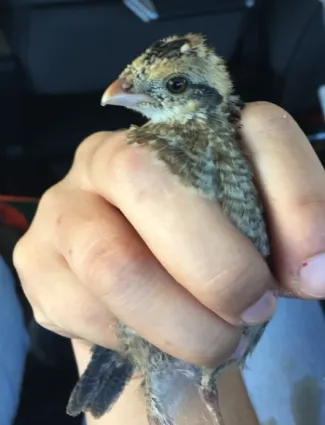
The entire month of August was spent trapping at Cross Timbers WMA. Trapping success remained low, most likely due to a combination of excessive heat, significant trap interference by cattle and wildlife, and the ongoing quail breeding season. Thus, only seven new quail were fitted with transmitters during August. There was evidence of successful breeding at Cross Timbers during the last 10 days of the month, when five quail chicks were captured from at least two different broods. Six downed transmitters were recovered during August, with three recovered from Beaver River WMA, one from Cross Timbers WMA, and two from Packsaddle WMA. Three showed obvious signs of predation, with two being attributed to raptor predation and one to mammal predation. One was determined to be hit by a vehicle and one to be a slipped harness. Upon inspection, it was discovered that one of the crimps on the slipped harness had not been fully closed allowing the harness ribbon to slip through, causing the harness to fall off the bird. The manufacturer’s analysis of the transmitter with broken antennas that was recovered from a recaptured bird in July suggested that the antennas had been twisted off due to external force. Therefore, 19 transmitters were redesigned with a sturdier antenna and are now deployed to evaluate if the new design can improve transmitter longevity. During August, a total of 21 transmitters were active across three of the four WMAs, with six active GPS transmitters at Beaver River WMA, 10 at Cross Timbers WMA, and five at Packsaddle WMA. All transmitters, except two at Packsaddle WMA, were of the type with satellite-download. In total, 35,062 individual locations have been collected since the launch of the first transmitter in July 2018.
Bird and vegetation surveys concluded during the second week of August. A total of 735 bird and vegetation surveys were completed across the four WMAs from mid-May to mid-August, with 191 surveys at Beaver River WMA, 178 at Cross Timbers WMA, 180 at Packsaddle WMA, and 186 at Sandy Sanders WMA. Computerization of survey data has been completed for all bird point count surveys and is ongoing for vegetation surveys. A total of 2,972 birds comprising 85 species were registered during the point count surveys.
Three new M.S. students were hired for the project. One will be primarily focused on vegetation responses to management, one will be focused on GPS data, and one will be focused on quail/bird community responses to shrub densities and management.
For the invertebrate work, processing samples that were collected at Packsaddle WMA has been ongoing. Invertebrates have identified, measured, and counted from 60 of the 480 pitfall trap samples and insects from 20 of 90 nutrient collection samples have been sorted. The samples collected in pitfall traps can be used to measure the diversity and abundance of arthropods but not their nutrient content, because they soaked in propylene glycol for up to 48 hours. The nutrient collection samples are a separate set of invertebrates that were collected with a couple of methods (primarily hand collection and sweep nets) and can be used for nutrient analysis since they were frozen soon after collection. By combining the two types of samples, it can be examined how current year burns and disking affected nutrient availability for quail. So far, grasshoppers (Orthoptera), beetles (Coleoptera), and true bugs (Hemiptera) have been well-represented in pitfall and sweep net samples. In terms of observations in the field at Packsaddle WMA, fewer quail were seen than last summer, but many bobwhite calls were heard at many of the invertebrate sampling locations over the course of the season. Turkeys were also consistently observed at several of the invertebrate sampling locations.